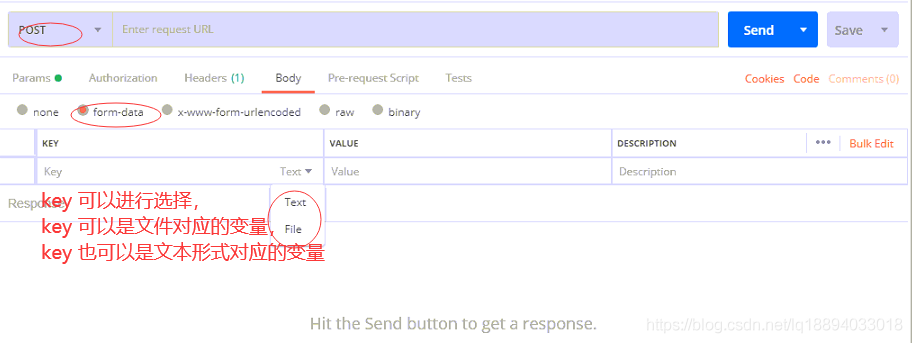postman模擬post請求的四種請求體
1.application/x-www-form-urlencoded
瀏覽器的原生 表單,其中ajax也是用這種方式提交的,主要是key-value 鍵值對的形式。一般的請求方式如下圖所示:

POST HTTP/1.1 Host: test.app.com Content-Type: application/x-www-form-urlencoded Cache-Control: no-cache Postman-Token: e00dbaf5-15e8-3667-6fc5-48ee3cc89758 key1=value1&key2=value2
POST中(application/x-www-form-urlencoded)請求方式截圖,主要在key中傳入接口中定義的變量,value 中傳入值就可以進行測試接口
2.multipart/form-data
它會將表單的數據處理為一條消息,以標簽為單元,用分隔符分開。既可以上傳鍵值對,也可以上傳文件。
由於有boundary隔離,所以multipart/form-data既可以上傳文件,也可以上傳鍵值對,它采用瞭鍵值對的方式,所以可以上傳多個文件,在springmvc中可以使用MultipartHttpServletRequest接收通過api根據"name"獲取不同的鍵值,也可以通過MulTipartFile數組接收多個文件。
POST HTTP/1.1 Host: test.app.com Cache-Control: no-cache Postman-Token: 59227787-c438-361d-fbe1-75feeb78047e Content-Type: multipart/form-data; boundary=----WebKitFormBoundary7MA4YWxkTrZu0gW ------WebKitFormBoundary7MA4YWxkTrZu0gW Content-Disposition: form-data; name="filekey"; filename="" Content-Type: ------WebKitFormBoundary7MA4YWxkTrZu0gW Content-Disposition: form-data; name="textkey" tttttt ------WebKitFormBoundary7MA4YWxkTrZu0gW--


PSOT同時上傳文件和鍵值對數據
3. raw
可以上傳任意格式的文本,可以上傳text、json、xml、html等Controller接口可以通過@RequestBody 來修飾,傳入數據就是JSON格式
註意: 在使用raw 方式,如果在PostMan再測試的時候需要在headers中添加一個key-value (Content-Type: application/json 或者對應的格式)

4.binary
相當於Content-Type:application/octet-stream,從字面意思得知,隻可以上傳二進制數據,通常用來上傳文件,由於沒有鍵值,所以,一次隻能上傳一個文件。

POST HTTP/1.1 Host: test.app.com Cache-Control: no-cache Postman-Token: 5ad66f08-6faa-aba0-744a-ca958b1a0fc2 undefined
提醒:
multipart/form-data與x-www-form-urlencoded區別:
html中的form 表單有兩種:application/x-www-form-urlencoded和multipart/form-data。application/x-www-form-urlencoded是默認的MIME內容編碼類型,它在傳輸比較大的二進制或者文本數據時效率極低。
MIME:
簡單說,MIME類型就是設定某種擴展名的文件用一種應用程序來打開的方式類型。服務器會將它們發送的多媒體數據的類型告訴瀏覽器,而通知手段就是說明該多媒體數據的MIME類型,服務器將 MIME標志符放入傳送的數據中來告訴瀏覽器使用哪種插件讀取相關文件。
multipart/form-data:既可以上傳文件等二進制數據,也可以上傳表單鍵值對,隻是最後會轉化為一條信息。當設置multipart/form-data,http會忽略 contentType 屬性。
x-www-form-urlencoded:隻能上傳鍵值對,不能用於文件上傳。不同的field是用&區分開的。這兩個類均實現瞭HttpEntity接口,使用如下:
public static String testUpload(String url) {
String result = null;
CloseableHttpClient httpclient = HttpClients.createDefault();
HttpPost httppost = new HttpPost(url);
try {
FileBody bin = new FileBody(new File("F:\\image\\sendpix0.jpg"));
StringBody comment = new StringBody("A binary file of some kind", ContentType.TEXT_PLAIN);
HttpEntity reqEntity = MultipartEntityBuilder.create().addPart("bin", bin).addPart("comment", comment)
.build();
httppost.setEntity(reqEntity);
System.out.println("executing request " + httppost.getRequestLine());
CloseableHttpResponse response = httpclient.execute(httppost);
try {
int statusCode = response.getStatusLine().getStatusCode();
if (statusCode == HttpStatus.SC_OK) {
result = EntityUtils.toString(response.getEntity(), "UTF-8");
}
} finally {
response.close();
httpclient.close();
}
} catch (ClientProtocolException e) {
e.printStackTrace();
} catch (IOException e) {
e.printStackTrace();
} finally {
try {
httpclient.close();
} catch (IOException e) {
e.printStackTrace();
}
}
return result;
}
public static String testParam(String url) {
String result = null;
CloseableHttpClient httpclient = HttpClients.createDefault();
httpclient = HttpsHelper.newHttpsCloseableClient();
HttpPost httpPost = new HttpPost(url);
List<NameValuePair> params = new ArrayList<NameValuePair>();
params.add(new BasicNameValuePair("key1", "value1"));
params.add(new BasicNameValuePair("key2", "value2"));
try {
httpPost.setEntity(new UrlEncodedFormEntity(params));
httpPost.setConfig(requestConfig);
CloseableHttpResponse httpResp = httpclient.execute(httpPost);
try {
int statusCode = httpResp.getStatusLine().getStatusCode();
if (statusCode == HttpStatus.SC_OK) {
result = EntityUtils.toString(httpResp.getEntity(), "UTF-8");
}
} finally {
httpResp.close();
httpclient.close();
}
} catch (UnsupportedEncodingException e) {
e.printStackTrace();
} catch (ClientProtocolException e) {
e.printStackTrace();
} catch (IOException e) {
e.printStackTrace();
} finally {
try {
httpclient.close();
} catch (IOException e) {
e.printStackTrace();
}
}
return result;
}
到此這篇關於postman模擬post請求的四種請求體的文章就介紹到這瞭,更多相關postman post請求內容請搜索WalkonNet以前的文章或繼續瀏覽下面的相關文章希望大傢以後多多支持WalkonNet!
推薦閱讀:
- HttpClient實現表單提交上傳文件
- 使用flask如何獲取post請求參數
- php使用file_get_contents(‘php://input‘)和$_POST的區別實例對比
- Vue之請求如何傳遞參數
- Java基於HttpClient實現RPC的示例